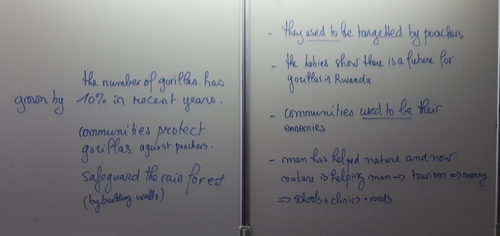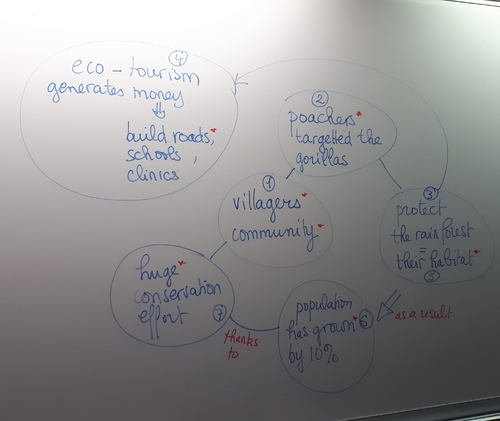-
SEQUENCE 2 : HEROES AND ROLE MODELS
HEROES AND ROLE MODELS
How do you define a hero?
A hero is a person who is strong and who saves people. It is also a person who represents important values. For example, I consider Martin Luther King or Nelson Mandela as heroes because they fought for other people and were courageous. Everyday people can be real life heroes if they do something exceptionally brave for instance.
How do you define a role model?
A role model is a person who inspires people because of who they are.
They should be kind.
We admire role models and they are popular.
They are examples for us because they do good things. They show us the way. They are often charismatic and do what they say. They embody values and show more courage than most people.
Categories of heroes and role models - activity page 43:
Cathy Freeman is an Australian athlete.
Robert Gould Shaw is a famous American war hero.
Homework : finir l'exercice et apprendre le cours.
09/10
Hour 1 :
A real-life superhero. Written comprehension page 45
Who was involved?
A victim : Cameron Hollopeter, 20, student at the New York film academy, has a stepmother.
A savior : Wesley Autrey, 50, 2 young daughters, construction worker and Navy veteran.
What happened?
Cameron fell onto the subway tracks and Wesley jumped onto the tracks to rescue him. He shielded the 20-year-old with his own body by rolling him into a gap between the tracks.
Both were unharmed = neither got hurt / injured.
Revision : fall - fell - fallen
Prépositions de lieux :
http://ekladata.com/4ZOVJ7PHh_OgQuyL7C5uAyHeN4c.jpg
Hour 2 :
Finir de relever les informations importantes dans le dernier paragraphe page 45. Se préparer à récapituler tout l'incident à l'oral (sans notes).
Wesley Autrey became very popular after rescuing Cameron from death. He was even awarded money and free subway tickets. More importantly, people consider him as a hero for his courageous action. He, on the other hand, doesn't consider himself as a hero. He thinks what he did was normal.
Gorillas in the mist page 46
Gorillas are an endangered species. They are tall mammals which can live up to 35 years, measure up to 1.8m and weigh up to 220 kg.
Dian Fossey was a woman who dedicated her life to the protection of gorillas. She was assassinated by poachers (people who hunt gorillas illegally).
Homework : page 46. remettre dans l'ordre les paragraphes du texte sur Dian Fossey. Apporter le livre.
15/10
Correction p 46 - CE
G D B F H C E A
Travail de groupe pour résumer le texte.
Homework : s'entraîner à parler de Dian Fossey en utilisant le résumé fait en groupes.
16/10
Hour 1:
Oral comprehension about mountain gorillas.
Schema mental fait à partir de notes pour servir de support à la prise de parole.
Notes :
a group of tourists
Rwanda / rain forest / volcanoes
nature now comes first in this region
encounter / family of 21 gorillas led by the silver-back Agasha = special
only 700 gorillas left in the world today
Hour 2 :
Suite de la compréhension orale.
Notes :
Homework : finir le schéma mental à partir des notes et s'entraîner à parler.
Apporter les livres.
05/11
Entraînement à la prise de parole en continu.
06/11
Hour 1:
Prise de parole en continu sur la vidéo "Gorillas in the mist"
Hour 2:
Compréhension écrite : page 47
Sir Edmund Hillary : a famous mountaineer
- an article from a newspaper called "the Telegraph" / 2008
1. What was Sir Edmund Hillary's native country? Edmund Hillary is from New Zealand. He was a "Kiwi"
2. When did he become famous? What for? He was the first man to reach the Everest peak on May, 29 1953.
3. Pick out all the words related to his humanitarian work. “... devote much of his life to aiding the mountain people of Nepal and set up the Himalayan Trust through which he built schools, hospitals and bridges in the region.” (l. 15) “... he wished to be remembered mostly for his humanitarian work.” (l. 21)
4. Find examples of his humility : “He never liked to be known as a hero, preferring to be called ‘Ed’ and considering himself just an ordinary beekeeper.” (l. 17) “Adventuring can be for the ordinary person with ordinary qualities, such as I regard myself,” (l. 28)
13/11
Hour 1 :
end of oral assessment
revision of word-making :
Hour 2 :
Superlatif :
repérage :
fast : the fastest / big : the biggest
rich : the richest / pretty : the prettiest
intelligent : the most intelligent / successful : the most successful
generous : the most generous
bad : the worst / good : the best
règle :
Pour exprimer le superlatif de supériorité (le plus...), on emploie :
the + terminaison -est pour les adjectifs d'une syllabe et ceux de 2 syllabes se terminant par -y.
the most + adjectif pour les autres adjectifs.
Attention aux règles orthographiques :
y devient iest
doubler la consonne lorsque la voyelle qui précède est courte:
"fit" devient "the fittest" mais "great" devient "the greatest" (diphtongue) et "short" devient "the shortest" (voyelle longue).
page 50 : être ou avoir?
On remarque plusieurs choses en lisant le texte sur Charlie Chaplin :
- les anglais utilisent souvent be là où nous utilisons avoir
he was not afraid : il n'avait pas peur
he was 78 : il avait 78 ans
he was lucky : il a eu de la chance
there were many jobs : il y avait beaucoup de travail
- tous ces verbes sont au prétérite alors qu'en français on utilise l'imparfait et le passé composé.
Homework : page 51 n°1 & 2 / Apporter les livres
19/11
Correction des exercices
Entraînement à la compréhension orale:
1. Identify the type of document and the speaker(s) - WHO?
type of recording : interview / documentary / conversation / monologue / testimonial / news report...
speaker(s) : gender (male or female) / role in the recording
interviewer : the person who asks the questions in an interview - journalist - presenter - the host...
interviewee : the person who answers the questions in an interview - the guest
2. Identify the general topic - WHAT?
3. Answer the other usual questions : Where? When? How? Why?...
4. Make sure you pick out significant details.
5. Write to say what you have understood.
Who's your hero?
20/11
Hour 1:
Recap :
This recording is an interview. A male host is interviewing Suzy. She speaks about an expedition she intends to do next spring. She is going to climb the north east ridge of Mount Everest raising funds for a charity. As a mountaineer she wants to contribute to the fight against cancer. She says she read a book about sir Edmund Hillary when she was little and he has been her hero ever since.
Ecoute partie 2:
Suzy remembers watching an interview of Sir Edmund in which he recalled his boyhood. He dreamed a lot when he was a child and read a lot of books about adventure. When he became a competent mountaineer, he went after the Himalayas and even went on expeditions to the Antarctic. He was a real adventurer.
Hour 2:
Compréhension orale partie 3 :
When he got older, he devoted his life to helping the Sherpas of Nepal. He organized expeditions and lead them but he became less active and maybe less sporty. He developed close friendships with the Sherpas. he raised money to build schools, bridges and hospitals. Later, he worried about the huge number of tourists who came and left rubbish everywhere. He was more interested in environmental matters. Suzy says he's an inspiration to her because he fulfilled his dreams and took risks to reach his goals.





